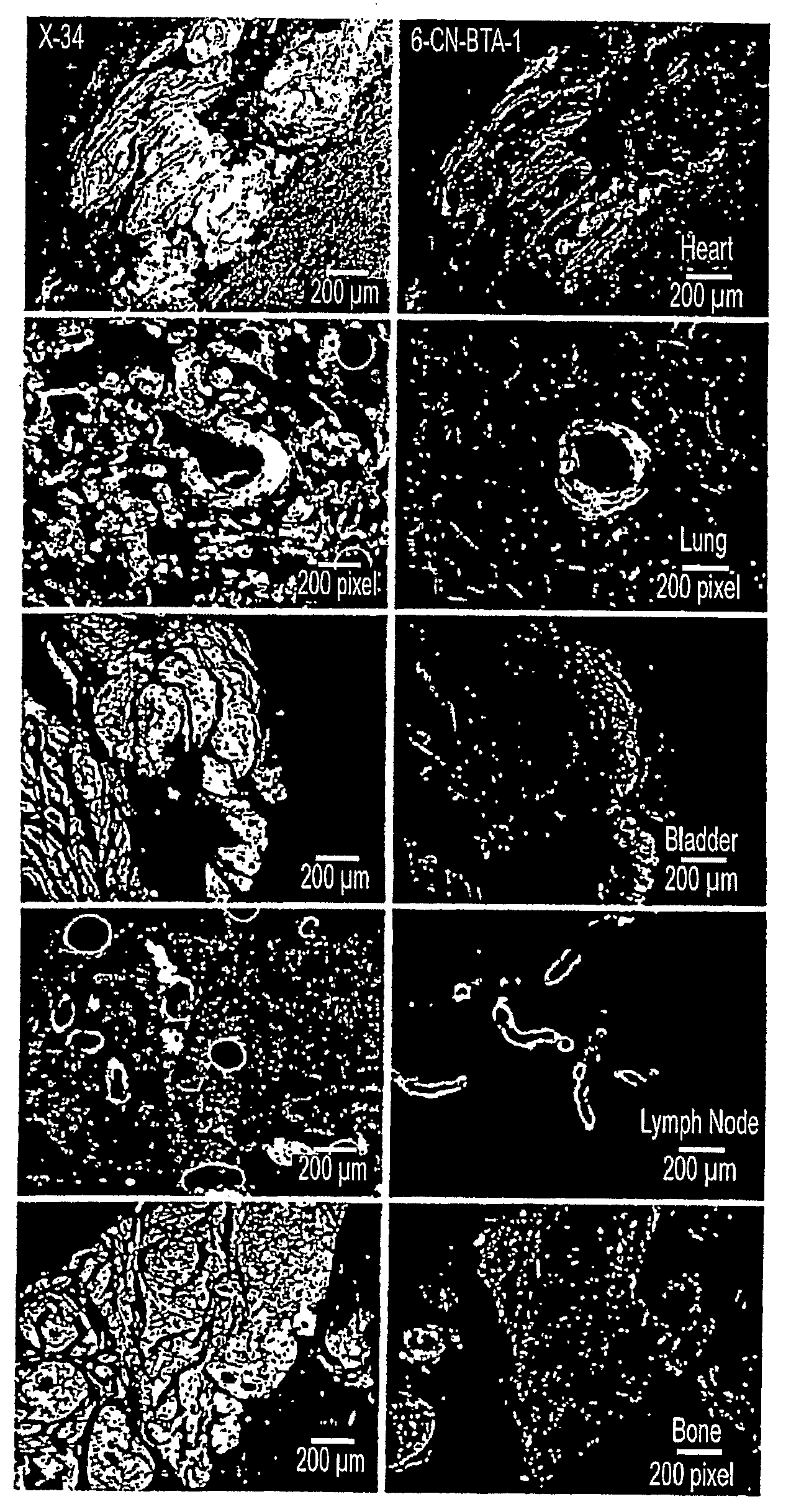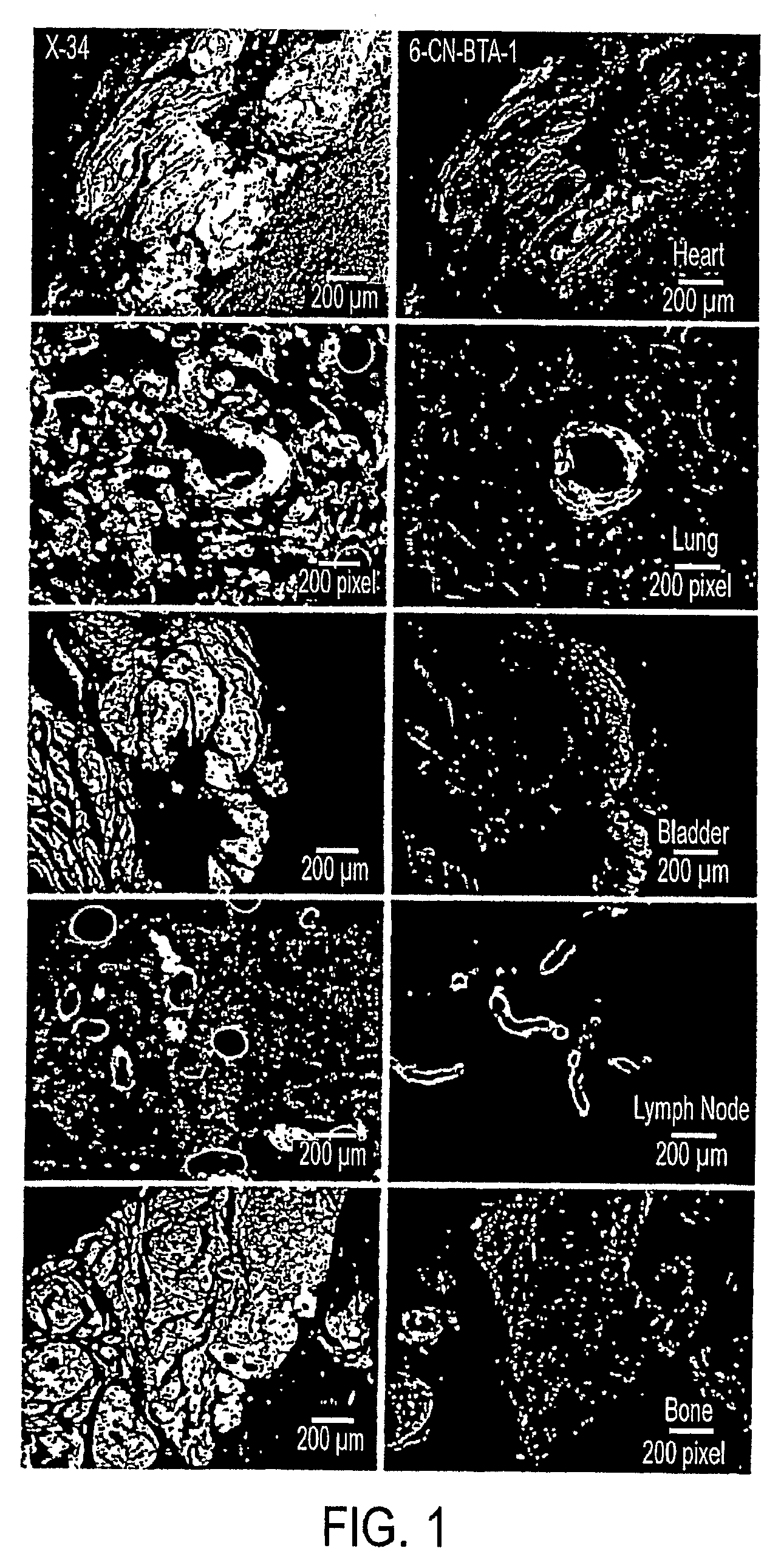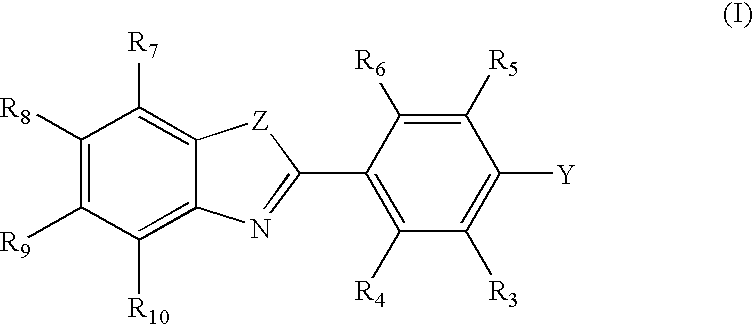In Vivo or in Vitro Method For Detecting Amyloid Deposits Having at Least One Amyloidogenic Protein
a technology of amyloid deposits and amyloidogenic proteins, which is applied in the field of in vivo or in vitro methods for detecting amyloid deposits having at least one amyloidogenic protein, can solve the problems of no organ system is spared, significant heart involvement is rare, and significant morbidity and death
- Summary
- Abstract
- Description
- Claims
- Application Information
AI Technical Summary
Problems solved by technology
Method used
Image
Examples
example 1
[N-Methyl-11C]2-(4′-Dimethylaminophenyl)-6-methoxy-benzothiazole was synthesized according to Scheme I
[0209]
[0210]Approximately 1 Ci of [11C]carbon dioxide was produced using a CTI / Siemens RDS 112 negative ion cyclotron by irradiation of a nitrogen gas (14N2) target containing 1% oxygen gas with a 40 μA beam current of 11 MeV protons for 60 minutes. [11C]Carbon dioxide is converted to [11C]methyl iodide by first reacting it with a saturated solution of lithium aluminum hydride in THF followed by the addition of hydriodic acid at reflux temperature to generate [11C]methyl iodide. The [11C]methyl iodide is carried in stream of nitrogen gas to a reaction vial containing the precursor for radiolabeling. The precursor, 6-CH3O-BTA-1 (1.0 mg, 3.7 μmoles), was dissolved in 400 μL of DMSO. Dry KOH (10 mg) was added, and the 3 mL V-vial was vortexed for 5 minutes. No-carrier-added [11C]methyl iodide was bubbled through the solution at 30 mL / minute at room temperature. The reaction was heated ...
example 2
2-(3′-125I-iodo-4′-amino-phenyl)-benzothiazol-6-ol was synthesized according to Scheme II
[0211]
[0212]To a solution of 2-(4′-aminophenyl)-6-methanesulfonoxy-benzothiazole (1 mg) in 250 μL acetic acid in a sealed vial was added 40 μL of chloramine T solution (28 mg dissolved in 500 μL acetic acid) followed by 27 μL (ca. 5 mCi) of sodium [125I]iodide (specific activity 2,175 Ci / mmol). The reaction mixture was stirred at room temperature for 2.5 hours and quenched with saturated sodium hydrogensulfite solution. After dilution with 20 ml of water, the reaction mixture was loaded onto C8 Plus SepPak and eluted with 2 ml methanol. For deprotection of the methaiesulfonyl group, 0.5 ml of 1 M NaOH was added to the eluted solution of radioiodinated intermediate. The mixture was heated at 50° C. for 2 hours. After being quenched by 500 μL of 1 M acetic acid, the reaction mixture was diluted with 40 mL of water and loaded onto a C8 Plus SepPak. The radioiodinated product, having a radioactivity...
example 3
2-(3-18F-Fluoro-4-methylamino-phenyl)-benzothiazol-6-ol was synthesized according to Scheme III
[0214]
[0215]A cyclotron target containing 0.35 mL of 95% [O-18]-enriched water was irradiated with 11 MeV protons at 20 μA of beam current for 60 minutes, and the contents were transferred to a 5 mL reaction vial containing 2 mg Cs2CO3 in acetonitrile (57 μL). The solution was evaporated to dryness at 110° C. under a stream of argon three times using 1 mL aliquots of acetonitrile. To the dried [F-18]fluoride was added 6 mg of 6-MOMO-BT-3′-Cl-4′-NO2 in 1 mL DMSO, and the reaction vial was sealed and heated to 120° C. for 20 minutes (radiochemical incorporation for this first radiosynthesis step was about 20% of solubilized [F-18]fluoride). To the crude reaction mixture was added 8 mL of water and 6 mL of diethyl ether, the mixture was shaken and allowed to separate. The ether phase was removed and evaporated to dryness under a stream of argon at 120° C. To the dried sample, 0.5 mL of absolu...
PUM
| Property | Measurement | Unit |
|---|---|---|
| pH | aaaaa | aaaaa |
| pH | aaaaa | aaaaa |
| pH | aaaaa | aaaaa |
Abstract
Description
Claims
Application Information
 Login to view more
Login to view more - R&D Engineer
- R&D Manager
- IP Professional
- Industry Leading Data Capabilities
- Powerful AI technology
- Patent DNA Extraction
Browse by: Latest US Patents, China's latest patents, Technical Efficacy Thesaurus, Application Domain, Technology Topic.
© 2024 PatSnap. All rights reserved.Legal|Privacy policy|Modern Slavery Act Transparency Statement|Sitemap



